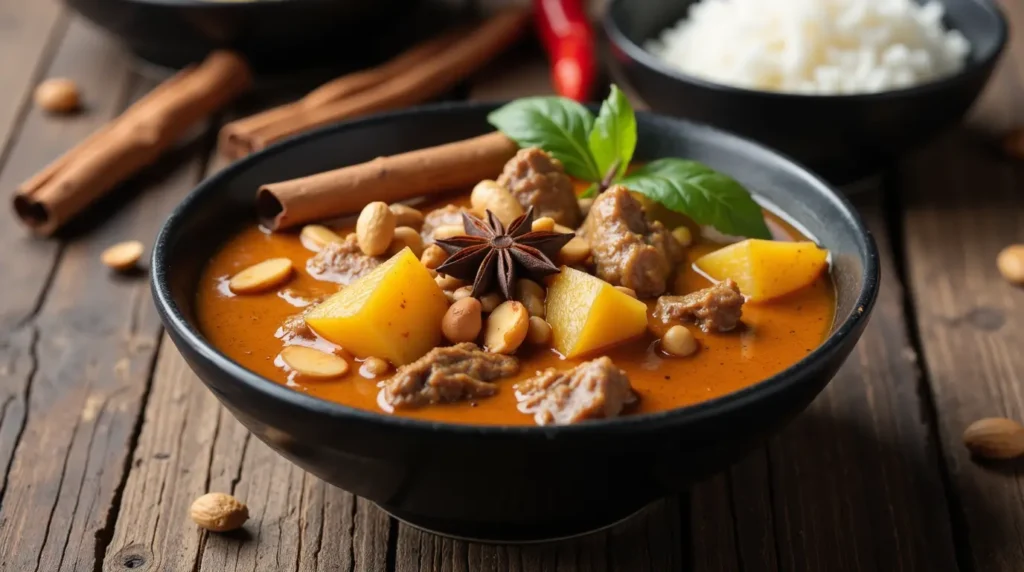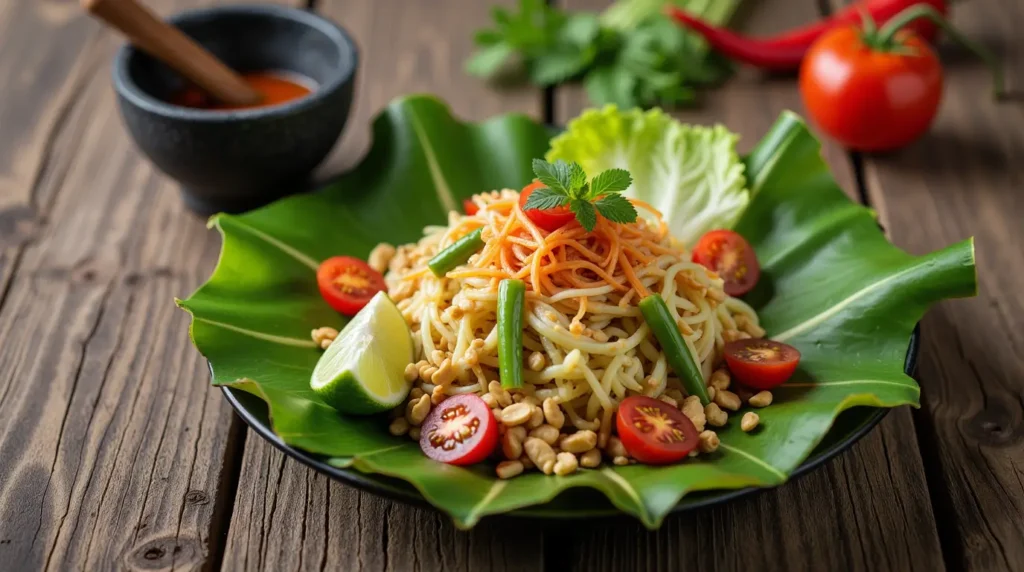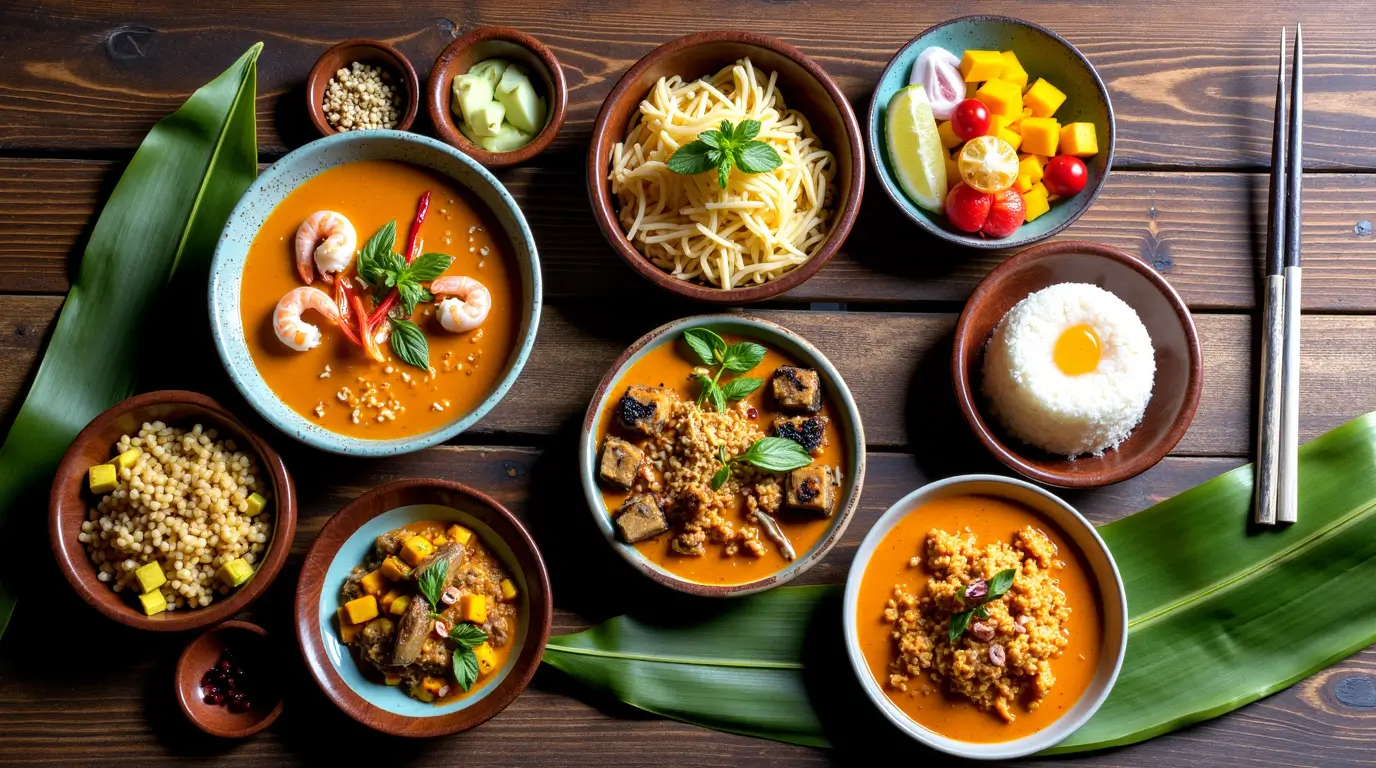Table of Contents
Table of Contents
Introduction
Thailand is not only famous for its vibrant culture, tropical beaches, and hospitable people but also for its rich and diverse cuisine. From tangy soups and aromatic curries to sweet desserts made with fragrant ingredients, Thai food captivates the senses and entices travelers and food enthusiasts worldwide. Few cuisines in the world combine sweetness, sourness, spiciness, and saltiness as expertly as Thai cuisine does, creating balanced, memorable flavors in every bite. The country’s gastronomic traditions are deeply interwoven with its geography, history, and cultural practices, making each meal a journey into Thailand’s heart and heritage.
In this article, we will explore the evolution of Cuisine of Thailand from its ancient beginnings to its modern fusion trends. We will delve into Thailand’s regional differences, essential ingredients, and cooking methods, illuminating what makes Thai food unique and irresistible. We will also offer practical tips on sourcing ingredients, highlight must-try dishes, and provide simplified recipes so you can recreate your own Thai feast at home. Finally, we will explore table rituals, cultural customs, and the exciting innovations that young chefs are bringing to the table. By the end, you will not only understand the depth and breadth of Thai culinary traditions but also feel inspired to sample authentic Thai dishes or try cooking them yourself.
Culinary Context and History of Cuisine of Thailand
Ancient Influences and the Development Cuisine of Thailand
Cuisine of Thailand has evolved over the centuries, influenced by the country’s geography, climate, migrations, and external cultural exchanges. The culinary story begins in ancient Siam, the old name for the central region of what is now Thailand, where agriculture was the backbone of society. Rice cultivation flourished in fertile valleys fed by rivers such as the Chao Phraya, and fishing thrived along coastlines and waterways. Early Thai diets revolved around rice, fish, vegetables, and fruits, often preserved through techniques like fermentation or drying. These preservation methods served practical needs, enabling food to last through the hot seasons and sustain communities in times of scarcity.
The influences from neighboring countries, especially India and China, played a significant role in shaping the foundations of Thai cooking. For instance, the introduction of spices and curries from Indian traders deeply impacted local gastronomy, helping to build the country’s now-iconic range of curries. Chinese migrants, on the other hand, contributed the techniques of stir-frying and noodle-making. Over time, these imported techniques and ingredients fused seamlessly with local staples, creating a culinary identity that would become distinctly Thai.
Cultural, Religious, and Geographic Shaping
Beyond trade interactions, Buddhism significantly influenced Thai gastronomy. With many Thais practicing Theravada Buddhism, vegetarian dishes and ritual offerings at temples remain vital aspects of culinary life. Monks rely on alms from the community, and this deeply rooted tradition has nurtured a culture of sharing food and offering it as a devotional act, imparting generosity and care in food preparation. Additionally, the Thai monarchy’s patronage helped preserve and elevate traditional dishes, ensuring that they remained part of the country’s cultural heritage.
Geography also played a pivotal role. Thailand’s central region, blessed with rice paddies and abundant water, developed meals centered around jasmine rice, fish, and vegetables. The coasts of the south, with access to the Andaman Sea and Gulf of Thailand, saw an infusion of seafood and a sharper spice profile, influenced in part by Malay and Indonesian cuisines. Meanwhile, the mountainous north and northeast (Isan) had to adapt to more challenging agricultural conditions, which gave rise to distinct ingredients and methods, such as the popularity of sticky rice and the use of preserved meats.
Historical Events and Key Influences
Thailand’s strategic location in Southeast Asia turned it into a cultural and commercial crossroads for centuries. Portuguese traders arrived during the 16th century, introducing chilies from the Americas, which quickly became a hallmark of Thai cooking. Chili peppers combined with local herbs (such as lemongrass, galangal, and kaffir lime leaves) and fermented sauces to create the aromatic and fiery dishes that define Thai cuisine today.
In the 19th and 20th centuries, as Thailand (then Siam) modernized and strengthened diplomatic ties with Western powers, the country’s culinary repertoire also expanded. European ingredients like wheat products, dairy items, and desserts started making appearances. Nevertheless, Thailand preserved its core identity by adapting foreign ideas to suit local palates, retaining a balance between sweet, salty, sour, and spicy flavors.
Regional Differences and Unique Characteristics
Thai cuisine is not monolithic. The country’s topography and historical migrations have produced four major regional cuisines:
- Central Thailand:
- Known for fragrant jasmine rice, mild curries, and a harmonious balance of flavors.
- Dishes like Tom Yum Goong (hot and sour shrimp soup) and Green Curry represent the central style well.
- Coconut milk is heavily used to create creamy curries with layered flavors.
- Northern Thailand:
- Influenced by the ancient Lanna Kingdom and neighboring Myanmar and Laos.
- Characterized by milder flavors, the prominence of sticky rice, and the use of fresh herbs.
- Dishes like Khao Soi (curry noodle soup) and Sai Ua (herbal sausage) are iconic here.
- Northeastern Thailand (Isan):
- Known for its strong, often spicy and sour flavors, with an emphasis on fresh vegetables and grilled or preserved meats.
- Salads like Som Tam (papaya salad) and dips such as Nam Prik (chili dips) define the local palate.
- Sticky rice is a staple, consumed with nearly every meal.
- Southern Thailand:
- Marked by robust spices, heat from chilies, and an abundance of fresh seafood.
- Islamic and Malay influences contribute to dishes such as Massaman Curry (a mild but richly spiced curry) and Khao Yam (a flavorful rice salad).
- Coconut milk and coconut-based products are integral due to the region’s coastal terrain and tropical climate.
These regional differences, shaped by geography, migration, and cultural contact, make Thai cuisine incredibly diverse. Yet, a unifying thread of fresh herbs, bold flavors, and communal dining ties the regions together under the larger umbrella of Thai gastronomy.
Key Ingredients and Local Products (Cuisine of Thailand)
Emblematic Foods
Thai cuisine features an array of vibrant ingredients that come together to create its signature layers of flavor:
- Jasmine Rice (Khao Hom Mali): Central to Thai meals, jasmine rice is fragrant, slightly sticky, and serves as the perfect canvas for rich curries and stir-fries.
- Sticky Rice (Khao Niao): Particularly in the north and northeast, sticky rice is rolled into small balls and eaten by hand with grilled meats, chili dips, and soups.
- Chilies (Prik): Introduced by the Portuguese, chilies in various forms—fresh, dried, pickled—provide heat and depth. Thai “bird’s eye” chilies are small but potent.
- Lemongrass (Ta Khrai): Used in soups, curries, and salads for its citrusy fragrance.
- Galangal (Kha): Similar to ginger but more peppery and citrusy, galangal is a cornerstone of Thai soups and curries.
- Kaffir Lime Leaves (Bai Makrut): Add intense lime fragrance to curries, soups, and stir-fries.
- Fish Sauce (Nam Pla): A salty, pungent sauce made from fermented fish; it is integral to Thai seasoning.
- Shrimp Paste (Kapi): Contributes a rich, savory depth to dips and curries.
- Coconut Milk (Nam Kati): Used in curries, desserts, and beverages, it adds creaminess and balances spiciness.
- Palm Sugar (Nam Tan Pip): A subtly sweetener derived from the sap of certain palm trees; used in desserts and to balance savory dishes.
Fresh vegetables and fruits—such as green papaya, eggplants (particularly the small, round Thai eggplants), morning glory, mangoes, and coconuts—provide brightness and textural variety to dishes. Proteins like chicken, pork, and seafood appear frequently, but vegetarian options abound in the form of tofu, mushrooms, and other plant-based ingredients.
Seasonality and Its Impact on Traditional Dishes
In Thailand, the tropical climate yields bountiful harvests of fruits and vegetables year-round, although certain items reach peak freshness at specific times. Mango season, typically from March to June, sparks a surge in mango-based desserts (like Mango Sticky Rice) and salads. In coastal regions, seafood is abundant throughout the year, though fishing conditions may affect supply during the monsoon season.
Rainy seasons also inspire heartier dishes, as people seek warming soups and curries. Seasonality is crucial in local markets, where Thai home cooks select ingredients for their daily meals, ensuring that the fare remains fresh, vibrant, and in tune with the climate. Ingredients like wild mushrooms, seasonal fruits, and specialty herbs appear in distinctive forms across different regions.
Tips on Purchasing Ingredients (Cuisine of Thailand)
For those looking to recreate Thai dishes at home:
- Local Markets or Specialty Grocery Stores: Visit Asian grocery stores for fresh lemongrass, galangal, kaffir lime leaves, and Thai chilies. These ingredients are becoming more widely available worldwide as Thai cuisine gains popularity.
- Online Shops: Hard-to-find items like shrimp paste or certain Thai sauces can often be sourced online.
- Adapt When Needed: If galangal or kaffir lime leaves are unavailable fresh, use dried or powdered forms—but expect a milder flavor. Lemongrass paste can substitute whole lemongrass stems if absolutely necessary, though the fresh version is preferred.
- Storing Herbs: Lemongrass, galangal, and kaffir lime leaves can be frozen without losing much flavor. This is a practical tip for those who cook Thai dishes occasionally.
Must-Try Traditional Dishes In Cuisine of Thailand
Cuisine of Thailand is abundant with unforgettable dishes, each offering a balance of sweet, sour, salty, and spicy flavors. Below are some of the country’s flagship dishes that every food lover should try at least once.
Tom Yum Goong (Hot and Sour Shrimp Soup) :

History and Characteristics
- Tom Yum Goong originated in central Thailand near the Chao Phraya River, where shrimp are plentiful.
- The soup’s foundation relies on a delicate yet bold combination of lemongrass, galangal, kaffir lime leaves, chilies, and fish sauce, resulting in an unmistakable balance of spicy, sour, and aromatic notes.
- The name “Tom Yum” essentially means “boiled spicy and sour,” and “Goong” refers to shrimp.
Simplified Recipe (Serves 2)
- Bring 3 cups of chicken or seafood stock to a simmer.
- Add 2 lemongrass stalks (trimmed and bruised), 4-5 slices of galangal, and 4-5 kaffir lime leaves (torn slightly).
- Toss in 2-3 Thai bird’s eye chilies (sliced) and 1 small onion (sliced).
- Season with 2 tablespoons of fish sauce and the juice of 1 lime.
- Add 8-10 peeled shrimp; simmer until shrimp are cooked (about 2-3 minutes).
- Taste and adjust with more lime juice (for sourness), fish sauce (for saltiness), or chilies (for heat).
- Garnish with cilantro leaves.
Regional Variations: In some areas, evaporated milk or chili jam is added for a slightly creamier texture and a reddish hue, known as Tom Yum Nam Khon.
Pad Thai (Stir-Fried Rice Noodles) :

History and Characteristics (Cuisine of Thailand)
- Pad Thai is a relatively modern dish popularized during the mid-20th century.
- It combines rice noodles stir-fried with eggs, tofu, shrimp, bean sprouts, and a sweet-savory-sour sauce made from tamarind pulp, fish sauce, and palm sugar.
- The dish reflects Chinese stir-fry influences, married with distinctly Thai flavors.
Simplified Recipe (Serves 2)
- Soak 200g of flat rice noodles in warm water until softened; drain.
- Heat 2 tablespoons of oil in a wok; add 1 chopped shallot and 100g of cubed tofu (optional) or shrimp. Stir-fry until lightly browned.
- Push ingredients to one side; crack 1 egg in the empty side; scramble.
- Add the drained noodles and pour over a sauce made from 2 tablespoons fish sauce, 2 tablespoons palm sugar (or brown sugar), and 1 tablespoon tamarind paste.
- Stir-fry briskly over high heat. Toss in a handful of bean sprouts and Chinese chives (if available).
- Garnish with crushed peanuts, lime wedges, and fresh bean sprouts.
Regional Variations: Pad Thai is most famous in central Thailand, though each vendor or household might adjust the sweetness or sourness to taste.
Green Curry (Gaeng Kiew Wan) :

History and Characteristics
- Green curry emerged from central Thai cuisine. Its name, “kiew wan,” translates to “sweet green,” referencing the curry’s fresh green color, not its level of sweetness.
- The curry paste consists of green chilies, lemongrass, galangal, kaffir lime rind, and shrimp paste, traditionally pounded in a mortar and pestle.
- Cooked with coconut milk, vegetables (like eggplant and bamboo shoots), and protein (chicken or tofu), green curry offers a creamy, spicy, and herbaceous flavor.
To make a quick version at home, you can buy pre-made green curry paste, sauté it in coconut milk, then add chicken or tofu and vegetables. Simmer until the flavors meld, and finish with fresh basil leaves.
Massaman Curry :

History and Characteristics
- Massaman Curry reflects southern Thai cuisine, strongly influenced by Persian and Malay cooking techniques.
- Characterized by warming spices like cardamom, cinnamon, and star anise, along with peanuts, this curry is milder compared to other Thai curries but rich in taste.
- Traditionally made with beef or chicken, slow-cooked with potatoes, onions, and peanuts in a coconut-based sauce.
Regional Variations: The southern regions often include local ingredients like dried spices and tamarind paste. Some families pass down closely guarded Massaman curry paste recipes from generation to generation.
Som Tam (Green Papaya Salad) :

History and Characteristics (Cuisine of Thailand)
- Som Tam hails from northeastern Thailand (Isan) and Laos. It is a refreshing salad featuring shredded green papaya, garlic, chilies, lime juice, fish sauce, and palm sugar pounded in a mortar and pestle.
- Variations can include salted crab, dried shrimp, fermented fish sauce (pla ra), or peanuts.
- Crisp, tangy, spicy, and slightly sweet, Som Tam is usually eaten with sticky rice and grilled chicken.
Regional Variations: In Isan, Som Tam Pla Ra uses fermented fish sauce for added pungency. In Bangkok, the dish might be sweeter, with peanuts and dried shrimp as standard garnishes.
Defining Characteristics of Thai Cuisine
Thai cuisine is best known for its harmonious interplay of flavors—spicy, sour, salty, and sweet. The skillful way these flavors balance each other defines Thai dishes, making them simultaneously comforting and exciting. Heat from chilies is often balanced by sweet palm sugar or creamy coconut milk, while the acidity of lime and tamarind brightens the savory depth of fish sauce. This layered complexity intrigues many food lovers seeking bold, contrasting tastes that burst with freshness.
Key seasonings—like fish sauce, lime juice, and chilies—inject a distinctive punch. For example, a simple stir-fry can gain a quintessential Thai flair by adding garlic, chili, and fish sauce. Beyond the flavors, the abundant use of fragrant herbs (basil, lemongrass, galangal) gives Thai cuisine a distinctive aroma, often described as “fresh” and “lively.” This appealing fusion of piquant, tangy, and herbal notes has caught the attention of global gourmets, especially those eager to explore new taste frontiers.
Tips and Highlights to Encourage People to Try Thai Cuisine
- A Taste Adventure: Thai food’s intricate flavor profile appeals to adventurous eaters who enjoy surprises—sometimes in a single bite, you taste sweet, hot, sour, and savory all at once.
- Cultural and Culinary Stories: Each dish has a story, often reflecting royal influences, local folklore, or family traditions. Trying Thai cuisine is not just about eating; it’s about connecting with Thailand’s cultural heartbeat.
- Accessibility: Even if you are new to cooking Asian dishes, Thai recipes can be relatively straightforward, especially with modern conveniences like pre-made curry pastes. This means you can enjoy an authentic taste of Thailand without too much difficulty.
- Healthy Aspects: Many Thai dishes emphasize fresh vegetables, herbs, and lean proteins. Stir-frying and steaming are common cooking methods, making Thai cuisine appealing to those looking for healthier options.
- Social Food: Thai meals are best enjoyed in a group, allowing you to sample a variety of dishes—curries, soups, salads, grilled meats—accompanied by shared bowls of rice. This communal aspect heightens the joy and discovery.
An anecdote worth noting: Many travelers remark that once they taste real Thai cuisine in Thailand—often from a humble street stall or a bustling night market—they begin an endless quest to replicate that authentic taste at home. It’s a testament to how memorable and addictive Thai flavors can be.
Table Rituals and Customs (Cuisine of Thailand)
Typical Meals: Breakfast, Lunch, and Dinner
- Breakfast: Thais may start the day with a comforting bowl of Jok (rice porridge) or Khao Tom (rice soup) seasoned with ginger, fish sauce, and garlic. Alternatively, a quick dish of fried rice or grilled pork skewers with sticky rice is common for those on the go.
- Lunch: Noodle soups or stir-fried noodles (Pad Thai, Pad See Ew) are popular midday meals due to their convenience and relatively quick preparation.
- Dinner: Often a communal affair involving several dishes served alongside rice—curries, stir-fries, soups, and salads. Everyone shares from central plates, highlighting the Thai cultural emphasis on sharing and community.
Snacks and desserts, like Mango Sticky Rice or savory spring rolls, can be enjoyed throughout the day. Street vendors are found in nearly every neighborhood, providing an array of bite-sized treats at any time.
Etiquette and Customs
Thai meals are usually served family-style, meaning everyone shares dishes placed at the center of the table. Diners spoon out small portions onto their personal plate of rice. An important point of etiquette is not to pile your personal plate with large amounts of food at once; instead, take smaller portions and go back for seconds if desired.
Traditionally, Thais used a spoon in the right hand and a fork in the left, the fork only serving to push food onto the spoon. Chopsticks are used primarily for noodles and are heavily influenced by Chinese culinary customs. If sticky rice is served, it is acceptable to use your hands, rolling the rice into small bites.
Respect for Food: Thai people consider wastefulness disrespectful, so try to avoid leaving large amounts of food uneaten. Additionally, it’s common courtesy to wait for the eldest or the highest-ranking person at the table to start eating first. Another important note: in Thai culture, placing your feet on a chair or pointing your feet toward someone is considered rude and should be avoided while dining.
Special Occasions and National Holidays (Cuisine of Thailand)
- Songkran (Thai New Year): Celebrated in mid-April, this holiday involves fun water fights in the streets and plenty of special foods, such as Khao Chae (rice soaked in fragrant iced water served with various side dishes).
- Loy Krathong (Festival of Lights): Held in the 12th month of the Thai lunar calendar, Thais float decorated baskets on waterways to pay respect to the water goddess. During this festival, you’ll find an array of street foods, sweet treats, and local specialties.
- Family Celebrations: Birthdays, weddings, and other events typically feature elaborate feasts, with dishes symbolizing good fortune, longevity, or harmony. Sweets and desserts—often infused with tropical fruits and coconut—are prevalent in such celebratory menus.
Modern Trends and Culinary Fusions (Cuisine of Thailand)
Global Influences and Fusion Cuisine
While Thailand remains proud of its culinary roots, it is also open to innovation. Tourism and global connectivity have introduced new ingredients and cooking techniques, leading to creative fusion concepts. Thai-style tacos with spicy pork and lemongrass, or sushi rolls filled with Thai curry-infused rice, are examples of imaginative blends you might encounter in Bangkok’s trend-setting restaurants.
Western techniques, such as sous-vide cooking, have also been adapted to Thai ingredients, offering new textures and presentations. In cosmopolitan areas like Bangkok and Chiang Mai, you can find restaurants that meld Italian pasta techniques with Thai flavors—think spaghetti with spicy Thai basil sauce or pizza topped with green curry chicken. While these might sound unconventional, many such experiments successfully merge beloved Thai tastes with internationally familiar formats.
New Consumption Trends
- Vegetarianism and Veganism: The abundance of fresh produce and aromatic herbs makes Thai cuisine a fertile ground for vegetarian and vegan dishes. Restaurants now often offer plant-based versions of Thai staples like Green Curry, Pad Thai, and Tom Yum, substituting meat with tofu, mushrooms, or jackfruit.
- Farm-to-Table and Organic Foods: A rising interest in sustainability and clean eating has sparked movements toward organic farming. Small-scale farms, especially in northern provinces, are focusing on pesticide-free produce and direct supply to local restaurants.
- Health-Conscious Adaptations: While traditional Thai cuisine is relatively healthy, some chefs are reducing sodium or sugar and experimenting with alternative sweeteners to cater to health-conscious diners.
Young Chefs and Restaurateurs
An exciting wave of young Thai chefs is merging traditional recipes with global techniques, earning recognition on the international stage. Many have trained abroad in Michelin-starred establishments and returned home to apply their newfound knowledge. Bangkok has emerged as a gastronomic capital in recent years, with several Michelin-starred restaurants offering innovative Thai cuisine.
- Chef Ian Pongtawat Chalermkittichai: A pioneer in modern Thai cuisine, blending French cooking methods with Thai flavor profiles.
- Chef Ton (Thitid Tassanakajohn): Known for elevating Thai street food into refined tasting menus, showcasing local ingredients and seasonal produce.
These culinary trailblazers champion local farmers and sustainable fishing practices, ensuring Thailand’s natural bounty remains a vibrant cornerstone of the cuisine. Their passion for preserving Thai heritage while boldly reinventing classic dishes resonates with a new generation of diners who crave authenticity with a contemporary twist.
Conclusion and Call to Action (Cuisine of Thailand)
Cuisine of Thailand stands at the intersection of taste, tradition, and innovation. From ancient preservation methods to modern-day fusion experiments, Thai food continues to captivate diners worldwide with its harmonious balance of flavors—spicy, sour, salty, and sweet—enriched by aromatic herbs and cultural nuances. We have journeyed through the country’s culinary context and history, explored regional variations, learned about the key ingredients that form the backbone of Thai cooking, and discussed must-try traditional dishes with simplified recipes to bring a slice of Thailand into your kitchen. We’ve also examined defining characteristics, table rituals, and contemporary trends, showcasing how Thai cuisine constantly evolves while remaining faithful to its roots.
Whether you’re a seasoned traveler longing for an authentic taste of Thailand or a curious home cook looking to experiment with new flavor profiles, now is the perfect time to dive deeper into Thai gastronomy. Perhaps you have your own favorite Thai dish, a culinary anecdote from your travels, or specific questions about ingredient substitutions. We encourage you to share your stories or pose your questions—culinary exploration is an ongoing journey, made richer by the experiences and insights of fellow food lovers.
In our next article, we may explore how Thai desserts—like the beloved Mango Sticky Rice or rarely seen specialties such as Foi Thong—connect with cultural festivals and daily indulgences. We hope this overview has whetted your appetite for more knowledge and encouraged you to step into your kitchen or a local Thai restaurant for a vibrant, mouthwatering adventure. Enjoy the flavors, customs, and generosity of Thai cuisine, and savor every spicy, aromatic, and delightful bite. Bon appétit—or as the Thais say, Kin hai aroi na! (Enjoy your meal!).

